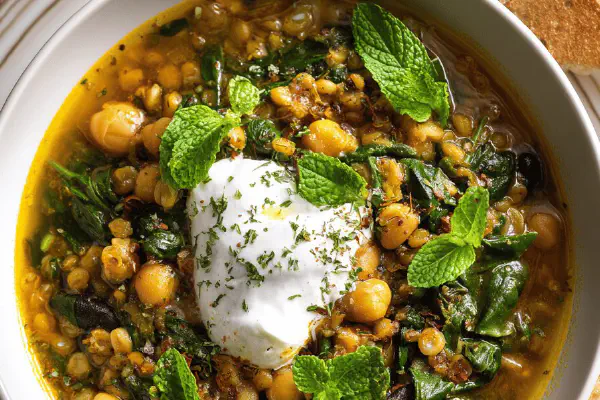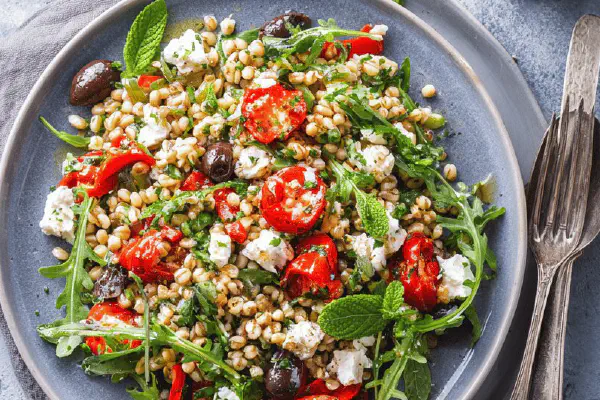Barley and Legume Soup

By Emma
Certified Culinary Professional
Ingredients
- 1 medium onion chopped
- 20 ml olive oil
- 1 clove garlic minced
- 5 ml ground turmeric
- 100 g green lentils rinsed
- 110 g pearled barley rinsed
- 1.5 liters vegetable broth
- 150 g baby spinach chopped
- 80 g coriander fresh packed, chopped
- 85 g parsley fresh packed, chopped
- 1 can 540 ml chickpeas rinsed and drained
- 1 can 540 ml black beans rinsed and drained
- Salt and cracked black pepper
- 15 g fresh mint chopped
- Greek yogurt or lemon wedges for serving
About the ingredients
Method
Soup
- Heat oil in a large pot over medium high. Toss in onions, sweat gently till translucent with a few browned bits; they should smell sweet and nutty, about 4 minutes. Add garlic and turmeric, stir constantly, 1.5 min, watch as aroma sharpens and turmeric brightens the mix. Throw in lentils, barley; toss to coat grains evenly. Season with salt and pepper now to let flavors marry early.
- Pour in vegetable broth, scrape any stuck bits from bottom. Bring to full rolling boil — hear it liven up, bubbles rushing. Lower heat to medium low, cover just right, simmer slow at steady tiny bubbles. After 38 min, test barley by squeezing; should yield but keep bite. Lentils will start to break apart, thickening broth.
- Add chopped spinach, coriander, parsley, chickpeas and black beans stirring gently. Leafy greens wilt quickly — see them fade and shrink to tender softness.Plenty of color contrast happening now. Cook uncovered 12 minutes more, taste for final seasoning. Soup thickens, rich, vibrant, steamy.
Garnish
- In small pan on medium high, gently heat a teaspoon olive oil, fingering garlic down till golden, spicy aroma bursts. Add fresh mint, toss briefly until mint releases bright punch; watch leaves crisp a little but not burn. Spoon that over soup bowls.
- Serve with cold yogurt dollop or fresh lemon wedge for zing; acidity balances earthiness well.
Notes and tweaks
- You can swap black beans for kidney or pinto, lentils for red or brown but cooking times vary. Barley gives great chew—sub quinoa or couscous for speed but texture differs completely. If broth reduces too fast, add water to keep soup loose. When reheated, add splash of broth to restore texture. If not into yogurt, creme fraiche or sour cream can substitute. Fresh herbs transform stale leftovers.
- Trust your nose and eyes more than clock. Onions golden means sugars freed; turmeric color deepens when cooked right. Lentils that break signal richness. Too harsh boil makes barley mushy, so low steady heat essential. Mint garnish—last step and quick or it goes bitter. Slow and steady is key here.
Cooking tips
Chef's notes
- 💡 Onions sweat low and slow; patience needed. Look for translucent with a little brown bits, not burnt. Aroma shifts from raw sharpness to sweet nuttiness. Garlic adds fragrance fast but burns easily—don’t rush; watch closely. Toss lentils and barley dry before stock to coat evenly and avoid clumps—salt early helps legume flavor soak in deep. Simmer steady—not wild boil. Bubbles soft, rhythmic. Barley softness is key test; pinch grains gently—firm but tender. Lentils break apart, thickening broth over time. Herbs go last for brightness. Mint hits hot oil fast; crisp but don’t burn leaves. Always taste near end; layers build steadily.
- 💡 Substitutions affect cooking times wildly. Black beans can swap kidney or pinto no sweat, but rinse well first to avoid clouding broth. Lentils vary—green hold shape; reds disintegrate fast. If pressed, quinoa or couscous in place of barley speeds total cook time but changes that chewy texture completely. Spinach can swap kale or chard; chop finely to match softness. Fresh herbs essential at end; dried herbs won't give that punch. If broth vanishes too fast, add water mid-simmer or toward end. Heat control is everything here.
- 💡 Garlic can be smashed instead of minced; bigger pieces brown slower, less risk of bitter overcook. Olive oil heats first; use quality if possible for flavor depth. In a pinch, sunflower or grapeseed oil work but lose nuance. Soup thickens in fridge; add splash of stock or water when reheating to loosen. Don’t stir obsessively—barley breaks down with too much agitation and ruins texture. Taste and adjust salt late; acidity from lemon or yogurt brightens earthiness at serving. Mint garnish last second for fresh aroma and slight crispness.
- 💡 Watch textures closely during cooking. After adding greens and beans, they wilt fast, lose volume. Color contrast is visual cue for timing. Broth thickens, steaming hot, rich hues from turmeric develop over simmer. If barley gets mushy, heat was too high or boiled wildly. Lentils soften progressively; broken ones thicken broth naturally. Mint in hot oil releases aromas but ignites if left too long. Add beans last but stir gently to preserve shape. If you skip yogurt, crème fraîche or sour cream works but changes flavor balance slightly. Adjust cooking time if using dried beans—soak overnight, simmer longer.
- 💡 Salt early on dry grains and legumes; helps flavor layer. When boiling stock, come to fast rolling boil but lower quickly to steady tiny bubbles—prevents barley mush. Testing barley softness by pinching grains is better than clock. Cook times vary with bean and lentil swaps. Leafy greens added last to avoid overcook; watch for tender but still vibrant. Mint garnish—quick toss in hot oil at the end releases punch without bitterness. Lemon wedges or yogurt serve last for acidity and creaminess contrast. If broth reduces too much, add water gradually—not all at once—maintains flavor concentration.
Common questions
Can I use dried beans?
Yes but soak overnight to soften. Cooking time much longer. Watch broth closely, might need more water. Rinsing canned saves time but flavor differs. Dried beans hold shape better if cooked properly. Soaked? Good idea to test after an hour. Add salt late if using dried.
What if barley gets mushy?
Too hot boil usually culprit. Aggressive stirring breaks grains down fast. Reduce heat once boiling is strong. Pinch test; barley should yield with bite. Maybe swap quinoa if low time but texture is very different. Keep gentle bubble simmer all through cooking. Lentils’ softness helps judge.
How to keep herbs fresh?
Add fresh herbs at very end. Dried herbs lose brightness in long cook. Mint turns bitter if cooked too long; toss in hot oil quick to get aroma only. Coriander and parsley fold in with greens and beans, stir gently. Store leftovers with fresh herbs separately if possible.
How to store leftovers?
Refrigerate in airtight container—thickens fast. Reheat with splash of broth or water to loosen texture. Stir often to avoid sticking or burning bottom. Can freeze but texture changes. Add fresh herbs and lemon or yogurt just before serving for freshness. Avoid reheating multiple times.



